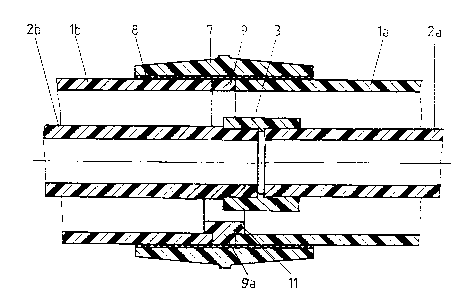Some of the information on this Web page has been provided by external sources. The Government of Canada is not responsible for the accuracy, reliability or currency of the information supplied by external sources. Users wishing to rely upon this information should consult directly with the source of the information. Content provided by external sources is not subject to official languages, privacy and accessibility requirements.
Any discrepancies in the text and image of the Claims and Abstract are due to differing posting times. Text of the Claims and Abstract are posted:
| (12) Patent: | (11) CA 2020414 |
|---|---|
| (54) English Title: | METHOD OF CONNECTING PIPES OF PLASTICS MATERIAL OF A DOUBLE PIPE SYSTEM AND A PIPE CONNECTION MADE BY THE METHOD |
| (54) French Title: | METHODE DE RACCORDEMENT DE TUYAUX EN MATIERES PLASTIQUES POUR RESEAU A DOUBLE TUYAU ET CONNEXION AINSI REALISEE |
| Status: | Expired and beyond the Period of Reversal |
| (51) International Patent Classification (IPC): |
|
|---|---|
| (72) Inventors : |
|
| (73) Owners : |
|
| (71) Applicants : |
|
| (74) Agent: | ROBIC AGENCE PI S.E.C./ROBIC IP AGENCY LP |
| (74) Associate agent: | |
| (45) Issued: | 1996-03-19 |
| (22) Filed Date: | 1990-07-04 |
| (41) Open to Public Inspection: | 1991-01-08 |
| Examination requested: | 1993-11-18 |
| Availability of licence: | N/A |
| Dedicated to the Public: | N/A |
| (25) Language of filing: | English |
| Patent Cooperation Treaty (PCT): | No |
|---|
| (30) Application Priority Data: | ||||||
|---|---|---|---|---|---|---|
|
A method of connecting pipes of plastics material of a
double pipe system and a pipe connection made by the method.
The inner pipes of the pipe system are connected to each
other with a sleeve member by welding or gluing. Clamping
jaws are used for holding and moving the inner pipes toward
each other. The outer pipes are shorter than the inner pipes
at least by the thickness of the two clamping jaws. For
bridging the gap between the outer pipes, an expandable
intermediate ring is inserted in the gap. An electric
welding sleeve is used for connecting the outer pipes and the
intermediate ring.
Note: Claims are shown in the official language in which they were submitted.
Note: Descriptions are shown in the official language in which they were submitted.

2024-08-01:As part of the Next Generation Patents (NGP) transition, the Canadian Patents Database (CPD) now contains a more detailed Event History, which replicates the Event Log of our new back-office solution.
Please note that "Inactive:" events refers to events no longer in use in our new back-office solution.
For a clearer understanding of the status of the application/patent presented on this page, the site Disclaimer , as well as the definitions for Patent , Event History , Maintenance Fee and Payment History should be consulted.
| Description | Date |
|---|---|
| Inactive: IPC from MCD | 2006-03-11 |
| Inactive: IPC from MCD | 2006-03-11 |
| Inactive: IPC from MCD | 2006-03-11 |
| Time Limit for Reversal Expired | 2001-07-04 |
| Letter Sent | 2000-07-04 |
| Grant by Issuance | 1996-03-19 |
| Request for Examination Requirements Determined Compliant | 1993-11-18 |
| All Requirements for Examination Determined Compliant | 1993-11-18 |
| Application Published (Open to Public Inspection) | 1991-01-08 |
There is no abandonment history.
| Fee Type | Anniversary Year | Due Date | Paid Date |
|---|---|---|---|
| MF (patent, 7th anniv.) - standard | 1997-07-04 | 1997-06-23 | |
| MF (patent, 8th anniv.) - standard | 1998-07-06 | 1998-06-19 | |
| MF (patent, 9th anniv.) - standard | 1999-07-05 | 1999-06-17 |
Note: Records showing the ownership history in alphabetical order.
| Current Owners on Record |
|---|
| GEORG FISCHER AG |
| Past Owners on Record |
|---|
| JORG WERMELINGER |